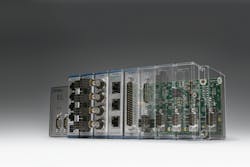Over the past few years, I’ve devoted a fair amount of attention to the impact embedded systems are having on industrial automation (see a list of several articles on this topic at end of this item). Most of that coverage has been spent explaining how embedded computing technologies, such as FPGAs (field programmable gate arrays), will change manufacturing controller applications due to the ability of FPGAs to be re-programmed in the field.
Until today, my exposure to such technologies revolved around controllers designed for specific applications. Now, with the release of National Instruments’ CompactRIO-9068 software designed controller, an FPGA-based re-programmable controller for wide applicability is now available. According to National Instruments, the new controller can address “any demanding embedded control and monitoring task” ranging from building “systems that can suppress fires on cargo airplanes and generating electricity through the flight of tethered kites to precisely stacking 20 tons of wet concrete.”
A key component of the cRIO-9068 controller is its use of the Xilinx Zynq-7020 All Programmable system on a chip (SoC), which combines a dual-core ARM Cortex-A9 processor and Xilinx 7 Series FPGA fabric. Using a 667 MHz dual-core ARM processor, the cRIO-9068 is reportedly four times faster than previous cRIO generations. The cRIO-9068 has an extended operating temperature range of -40 °C to 70 °C.
National Instruments says it built the cRIO-9068 on Linux to make the controller as open as possible and to allow for the development of third party applications by the Linux community. According to National Instruments, the cRIO-9068’s Linux-based, real-time OS can be used by both LabView Real-Time and C/C++ application developers.
Bob Leigh, president and CEO of LocalGrid Technologies, has already employed the cRIO-9068 in applications with Toronto Hydro, which delivers electricity to approximately 719,000 customers in the city of Toronto, Canada. Discussing his experience with the new controller in porting over existing LabView code from a cRIO-9074, Leigh says, “Within 24 hours of receiving the cRIO-9068 controller, we ran our existing LabView application software without any problems.”
Backwards compatibility of the new cRIO system was a key consideration according to David Fuller, vice president of applications and embedded software at National Instruments. “Because so many customers have invested in CompactRIO, the R&D teams… [maintained] complete backward code compatibility,” he says.
In LocalGrid’s work with Toronto Hydro, Leigh says he is working with the utility to “collect more data and employ algorithms to improve electricity distribution. Together we can use CompactRIO to revolutionize the grid.”
Along with the release of the cRIO-9068, National Instruments has also made available LabVIEW 2013 support for the NI Linux Real-Time OS. LabVIEW 2013 includes new features ranging from improved code management to handle documentation and debugging, software engineering tools, mobile and web support, and an “improved deployment experience” through incorporation of the new Deploy tool from Wirebird Labs.
Other embedded coverage from Automation World:
- How Embedded Systems Are Changing Automation
- Understanding Embedded
- Altera’s Presentation at The Automation Conference 2013: How New ARM Technology Will Impact Factory Automation System Design Capabilities
- Automation Suppliers Leverage New Embedded Tech
Leaders relevant to this article:


